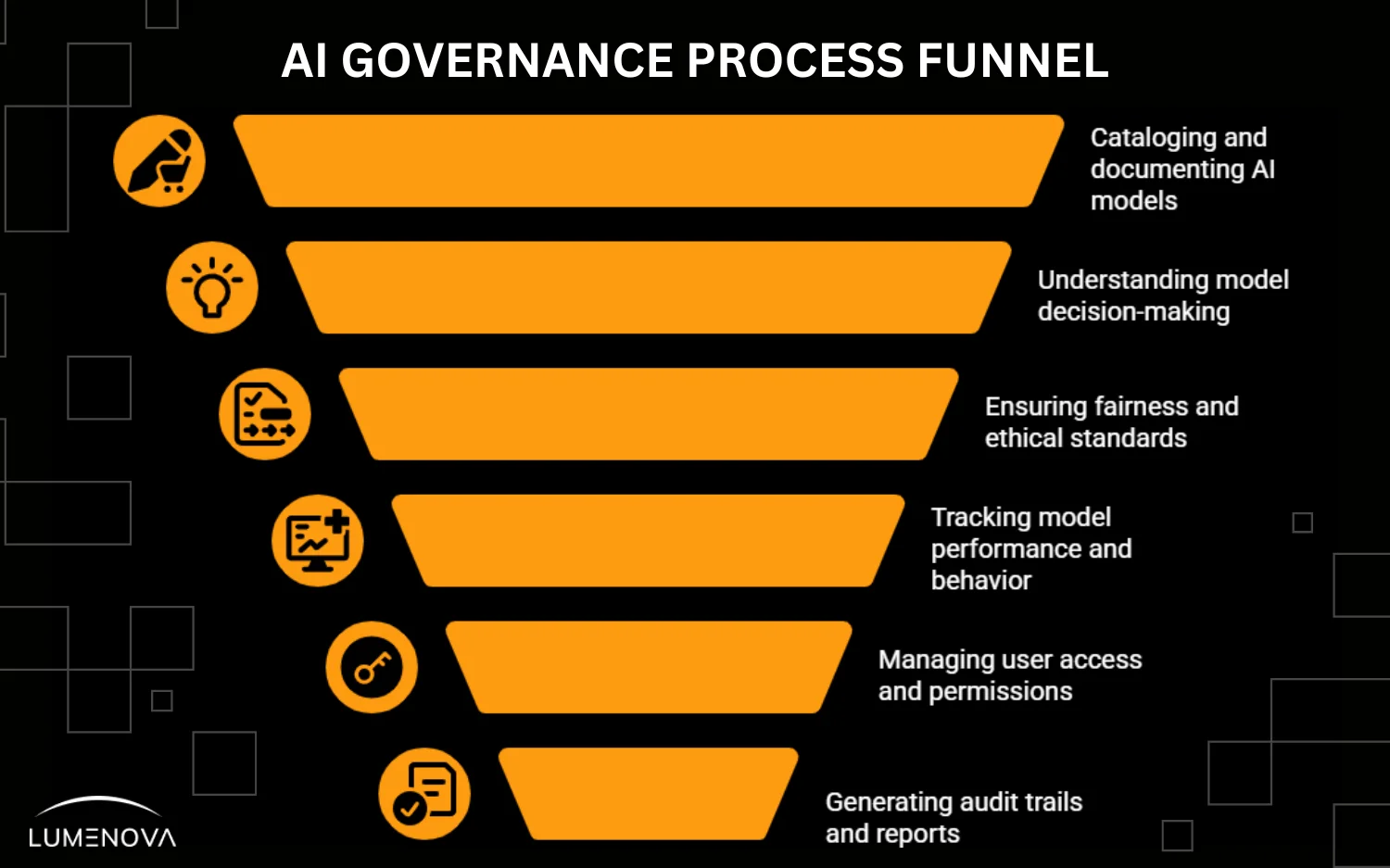AI Governance Software
AI governance software refers to a category of tools and platforms built to help organizations oversee and manage AI systems in a structured, transparent, and compliant way. These solutions provide the technical infrastructure needed to apply policies, monitor behavior, manage risk, and maintain accountability across the AI lifecycle (from development through deployment and beyond).
As AI becomes more embedded in enterprise operations, governance software plays a critical role in ensuring that these systems are used responsibly and aligned with regulatory, ethical, and organizational standards.
Why AI Governance Software Matters
The push for AI adoption has outpaced the establishment of reliable oversight. Many organizations now have models in production that impact customers, employees, and business operations, but they lack the systems needed to understand what those models are doing, why, and whether they’re behaving as expected.
AI governance software fills that gap. It affords visibility, control, and accountability to a space that has historically lacked all three.
Key Challenges That AI Governance Software Solves
Lack of transparency
Many AI models, especially deep learning systems, operate as black boxes. Governance software provides tools for explainability, documentation, and version control to demystify model behavior.
Compliance pressure
From GDPR to the AI Act and SEC regulations, compliance expectations are growing. AI governance software helps ensure systems are auditable, properly documented, and aligned with legal requirements.
Risk exposure
Unmonitored AI can produce biased, harmful, or incorrect outcomes. Governance tools enable early detection of drift, bias, or adversarial behavior before they turn into real-world incidents.
Operational inconsistency
Different teams often use different AI tools, frameworks, or workflows. Governance platforms centralize oversight and standardize how AI systems are built, evaluated, and deployed.
By solving these problems, AI governance software not only protects the business but also accelerates the responsible use of AI at scale.

Core Features of AI Governance Software
While platforms vary, most effective AI governance solutions share a common set of features:
1. Model Inventory and Documentation
Governance starts with visibility. These tools allow teams to track every model in development or production, including metadata about training data, intended use, ownership, and change history. This creates a single source of truth for AI assets.
2. Explainability and Decision Traceability
Explainability tools help teams understand how models make decisions. Whether it’s feature importance, SHAP values, or decision trees, governance software makes these insights accessible, not just to developers, but to risk, legal, and compliance teams.
3. Bias and Fairness Auditing
To meet ethical and regulatory standards, AI systems must be tested for bias and discrimination. AI governance software provides automated tools for fairness checks and demographic analysis, flagging disparities before deployment.
4. Performance Monitoring and Drift Detection
Once a model is live, it needs to be monitored for changes in performance or behavior. Governance software includes real-time alerts and visualizations for concept drift, accuracy shifts, and anomalous activity.
5. Access Control and Policy Enforcement
Not every user should have access to every model or dataset. Governance software supports role-based access, workflow approvals, and policy enforcement, so AI stays secure and compliant by design and operation.
6. Audit Logs and Compliance Reporting
Every decision, change, and action is tracked. This provides a full audit trail for regulators, internal reviews, or external certification processes.
AI Governance Software and Responsible AI
The rise of Responsible AI has pushed governance from a “nice-to-have” to a core business function. Responsible AI refers to a set of principles (fairness, transparency, accountability, privacy, and security) that guide how AI should be built and used.
AI governance software operationalizes these principles. It transforms them from broad goals into actual processes. With the right platform in place, organizations can move from reactive AI management to proactive governance, spotting problems early, documenting decisions, and building systems that can scale safely.
Who Uses AI Governance Platforms?
AI governance software is relevant across industries, especially critical in sectors with high regulatory pressure or public accountability:
- Financial services: To meet transparency and risk disclosure requirements in credit scoring, fraud detection, and investment automation.
- Healthcare: For auditing models used in diagnostics, patient triage, and clinical decision support.
- Public Sector: To ensure algorithms used in benefits, law enforcement, or hiring are transparent and fair.
- Retail and Marketing: For responsible personalization and data protection across consumer-facing models.
- Tech and Product Teams: To coordinate machine learning operations across departments and ensure consistent oversight.
Any organization using AI at scale can benefit from a structured, software-supported approach to governance.
Lumenova AI and AI Governance at Scale
At Lumenova AI, we provide a comprehensive platform that helps organizations operationalize AI governance from day one. Our tools support full lifecycle management, from model documentation and risk tracking to explainability, monitoring, and audit readiness.
We help teams not just keep up with regulations, but get ahead of them. In AI, trust is earned through oversight, not promises.
Final Thought
AI governance software is no longer optional. As AI systems gain more autonomy, the risks grow, but so do the expectations for responsible deployment. Whether you’re scaling your AI operations or just starting, governance software gives you the structure and visibility to move forward with confidence.
If your AI is driving decisions, shaping products, or impacting people, make sure governance is built in, not bolted on.